Tracking Long-Distance Systematic Trajectories of Different Robot Mower Patterns with Enhanced Custom-Built Software
Abstract
:1. Introduction
2. Materials and Methods
2.1. Experimental Field Trials
2.2. Assessment
2.3. Statistical Analysis
3. Results
Operative Parameters Analysis
4. Discussion
5. Conclusions
Author Contributions
Funding
Data Availability Statement
Acknowledgments
Conflicts of Interest
References
- Fidanza, M. Achieving Sustainable Turfgrass Management; Burleigh Dodds Science Publishing: Cambridge, UK, 2023; Volume 125. [Google Scholar]
- Pk, R.; Patel, N. Autonomous Lawn Mower—A Comprehensive Review. Int. Res. J. Adv. Sci. Hub 2023, 5, 420–428. [Google Scholar] [CrossRef]
- Shaddox, T.; Munshaw, G.; Cropper, K. Cut Quality of Turfgrass Leaves as Influenced by Robotic and Rotary Mowers. In Proceedings of the 2020 ASA-CSSA-SSSA International Annual Meeting, Virtual, 9–13 November 2020. [Google Scholar]
- Shaddox, T.; Cropper, K.; Qian, C. Robotic Mowers and Turfgrass Cut Quality. Robot vs. Rotary: Research at the University of Kentucky Compared the Mowers’ Effects on Leaf Cut Quality and Leaf Tip Chlorosis. Available online: https://www.gcmonline.com/research/news/robotic-mower-cut-quality (accessed on 13 January 2025).
- Boeri, P.A.; Lindsey, A.J.; Unruh, J.B. Autonomous Compared with Conventional Mower Use on St. Augustinegrass Lawn Quality. HortTechnology 2023, 33, 377–380. [Google Scholar] [CrossRef]
- Luglio, S.M.; Frasconi, C.; Gagliardi, L.; Raffaelli, M.; Peruzzi, A.; Volterrani, M.; Magni, S.; Fontanelli, M. Analysis of Football Pitch Performances Based on Different Cutting Systems: From Visual Evaluation to YOLOv8. Agronomy 2024, 14, 2645. [Google Scholar] [CrossRef]
- Hossain, M.; Takahashi, K.; Komatsuzaki, M. Robotic Lawnmower Saves Labor and Operation Costs in a Pear (Pyrus pyrifolia) Orchard. Jpn. J. Farm Work Res. 2020, 55, 143–153. [Google Scholar] [CrossRef]
- Xu, J.; Lai, J.; Guo, R.; Lu, X.; Xu, L. Efficiency-Oriented MPC Algorithm for Path Tracking in Autonomous Agricultural Machinery. Agronomy 2022, 12, 1662. [Google Scholar] [CrossRef]
- Luglio, S.M.; Sportelli, M.; Frasconi, C.; Raffaelli, M.; Gagliardi, L.; Peruzzi, A.; Fortini, V.; Volterrani, M.; Magni, S.; Caturegli, L.; et al. Monitoring Autonomous Mowers Operative Parameters on Low-Maintenance Warm-Season Turfgrass. Appl. Sci. 2023, 13, 7852. [Google Scholar] [CrossRef]
- Gagliardi, L.; Fontanelli, M.; Luglio, S.M.; Frasconi, C.; Raffaelli, M.; Peruzzi, A.; Caturegli, L.; Sciusco, G.; Federighi, T.; Magni, S.; et al. Assessment of the Effects of Autonomous Mowers on Plant Biodiversity in Urban Lawns. Horticulturae 2024, 10, 355. [Google Scholar] [CrossRef]
- Winkler, J.; Pasternak, G.; Sas, W.; Hurajová, E.; Koda, E.; Vaverková, M.D. Nature-Based Management of Lawns—Enhancing Biodiversity in Urban Green Infrastructure. Appl. Sci. 2024, 14, 1705. [Google Scholar] [CrossRef]
- Lerman, S.B.; Contosta, A.R.; Milam, J.; Bang, C. To Mow or to Mow Less: Lawn Mowing Frequency Affects Bee Abundance and Diversity in Suburban Yards. Biol. Conserv. 2018, 221, 160–174. [Google Scholar] [CrossRef]
- Hoffmann, M.; Clemens, J.; Stronzek-Pfeifer, D.; Simonelli, R.; Serov, A.; Schettino, S.; Runge, M.; Schill, K.; Buskens, C. Coverage Path Planning and Precise Localization for Autonomous Lawn Mowers. In Proceedings of the 2022 Sixth IEEE International Conference on Robotic Computing (IRC), Naples, Italy, 5–7 December 2022; pp. 238–242. [Google Scholar]
- Kaur, B.; Mansi; Dimri, S.; Singh, J.; Mishra, S.; Chauhan, N.; Kukreti, T.; Sharma, B.; Singh, S.P.; Arora, S.; et al. Insights into the Harvesting Tools and Equipment’s for Horticultural Crops: From Then to Now. J. Agric. Food Res. 2023, 14, 100814. [Google Scholar] [CrossRef]
- Hutsol, T.; Kutyrev, A.; Kiktev, N.; Biliuk, M. Robotic Technologies in Horticulture: Analysis and Implementation Prospects. Agric. Eng. 2023, 27, 113–133. [Google Scholar] [CrossRef]
- Sara, G.; Todde, G.; Pinna, D.; Caria, M. Evaluating an Autonomous Electric Robot for Real Farming Applications. Smart Agric. Technol. 2024, 9, 100595. [Google Scholar] [CrossRef]
- Liu, L.; Liu, H.; Wang, X.; Li, J.; Wang, P.; Liu, S.; Zou, J.; Yang, X. Application of Path Planning and Tracking Control Technology in Mower Robots. Agronomy 2024, 14, 2473. [Google Scholar] [CrossRef]
- Bochtis, D.; Griepentrog, H.W.; Vougioukas, S.; Busato, P.; Berruto, R.; Zhou, K. Route Planning for Orchard Operations. Comput. Electron. Agric. 2015, 113, 51–60. [Google Scholar] [CrossRef]
- Fragapane, G.; De Koster, R.; Sgarbossa, F.; Strandhagen, J.O. Planning and Control of Autonomous Mobile Robots for Intralogistics: Literature Review and Research Agenda. Eur. J. Oper. Res. 2021, 294, 405–426. [Google Scholar] [CrossRef]
- Fu, W.; Liu, Y.; Zhang, X. Research on Accurate Motion Trajectory Control Method of Four-Wheel Steering AGV Based on Stanley-PID Control. Sensors 2023, 23, 7219. [Google Scholar] [CrossRef]
- Saggini, E.; Zereik, E.; Bibuli, M.; Ranieri, A.; Bruzzone, G.; Caccia, M.; Riccomagno, E. Evaluation and Comparison of Navigation Guidance and Control Systems for 2D Surface Path-Following. Annu. Rev. Control 2015, 40, 182–190. [Google Scholar] [CrossRef]
- Qiao, J.; Guo, J.; Li, Y. Simultaneous Localization and Mapping (SLAM)-Based Robot Localization and Navigation Algorithm. Appl. Water Sci. 2024, 14, 151. [Google Scholar] [CrossRef]
- Zhang, M.; Ji, Y.; Li, S.; Cao, R.; Hongzhen, X.; Zhang, Z. Research Progress of Agricultural Machinery Navigation Technology. Trans. Chin. Soc. Agric. Mach. 2020, 51, 4. [Google Scholar]
- Sun, Q.C.; Xia, J.C.; Foster, J.; Falkmer, T.; Lee, H. Pursuing Precise Vehicle Movement Trajectory in Urban Residential Area Using Multi-GNSS RTK Tracking. Transp. Res. Procedia 2017, 25, 2356–2372. [Google Scholar] [CrossRef]
- Sportelli, M.; Luglio, S.M.; Caturegli, L.; Pirchio, M.; Magni, S.; Volterrani, M.; Frasconi, C.; Raffaelli, M.; Peruzzi, A.; Gagliardi, L.; et al. Trampling Analysis of Autonomous Mowers: Implications on Garden Designs. AgriEngineering 2022, 4, 592–605. [Google Scholar] [CrossRef]
- Denny, G.C.; Hansen, G. Right Plant, Right Place: The Art and Science of Landscape Design—Plant Selection and Siting: ENH1156/EP416, 2/2010. EDIS 2010, 2010, 1–5. [Google Scholar] [CrossRef]
- Sportelli, M.; Fontanelli, M.; Pirchio, M.; Frasconi, C.; Raffaelli, M.; Caturegli, L.; Magni, S.; Volterrani, M.; Peruzzi, A. Robotic Mowing of Tall Fescue at 90 Mm Cutting Height: Random Trajectories vs. Systematic Trajectories. Agronomy 2021, 11, 2567. [Google Scholar] [CrossRef]
- Forbes, S.; Cooper, D.; Kendle, A.D. The History and Develop- Ment of Ecological Landscape Styles. In Urban Nature Conservation-Landscape Management in the Urban Countryside; Kendle, T., Forbes, S., Eds.; Routledge: London, UK, 1997; pp. 244–254. [Google Scholar]
- Busey, P. Cultural Management of Weeds in Turfgrass. Crop Sci. 2003, 43, 1899–1911. [Google Scholar] [CrossRef]
- Saha, S.; Morita, T.; Ospina, R.; Noguchi, N. A Vision-Based Navigation System for an Agricultural Autonomous Tractor. IFAC-PapersOnLine 2022, 55, 48–53. [Google Scholar] [CrossRef]
- Saha, S.; Morita, T.; Noguchi, N. A Vision-Based Road Detection System for the Navigation of an Agricultural Autonomous Tractor. Eng. Agric. Environ. Food 2023, 16, 43–52. [Google Scholar] [CrossRef] [PubMed]
- Diwakaran, S.; Kumar, M.D.V.; Mohanreddy, P.S.; Rishika, C.; Sreenivasulu, P.; Sivasubramanian, M. Design of an Autonomous Mower with Height Adjustable Cutting Motor. In Proceedings of the 2023 4th International Conference on Signal Processing and Communication (ICSPC), Coimbatore, India, 23 March 2023; pp. 348–352. [Google Scholar]
- Tang, Q.; Schiehlen, W. From Lawnmower Dynamics to Modeling, Simulation and Experiments of a Differentially Driven Robot. In Advances on Theory and Practice of Robots and Manipulators; Mechanisms and Machine Science; Ceccarelli, M., Glazunov, V., Eds.; Springer: Cham, Switzerland, 2014; Volume 22. [Google Scholar]
- Broderick, P.L.; Cipra, R.J. A Method for Determining and Correcting Robot Position and Orientation Errors Due to Manufacturing. J. Mech. Transm. Autom. Des. 1988, 110, 3–10. [Google Scholar] [CrossRef]
- Li, Y.; Zhao, B.; Zhang, W.; Wei, L.; Zhou, L. Evaluation of Agricultural Machinery Operational Benefits Based on Semi-Supervised Learning. Agriculture 2022, 12, 2075. [Google Scholar] [CrossRef]
- Landschoot, P. Managing Thatch in Lawns. 2023. Available online: https://extension.psu.edu/managing-thatch-in-lawns (accessed on 13 January 2025).
- University of Massachusetts Amhers UMass Extension Turf Program. 9. Traffic Stress & Turf Cultivation. Available online: https://ag.umass.edu/turf/publications-resources/best-management-practices/9-traffic-stress-turf-cultivation (accessed on 13 January 2025).
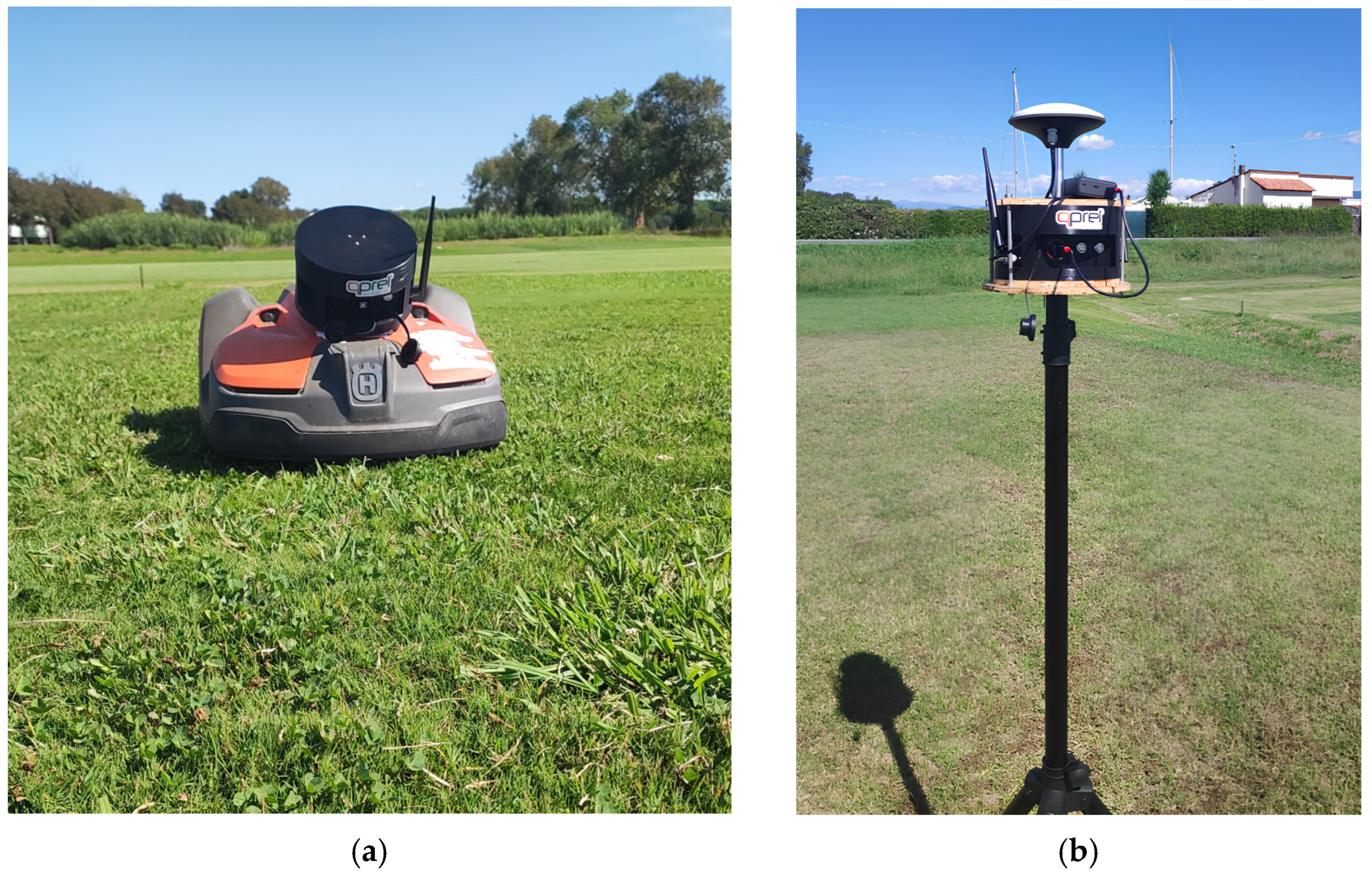


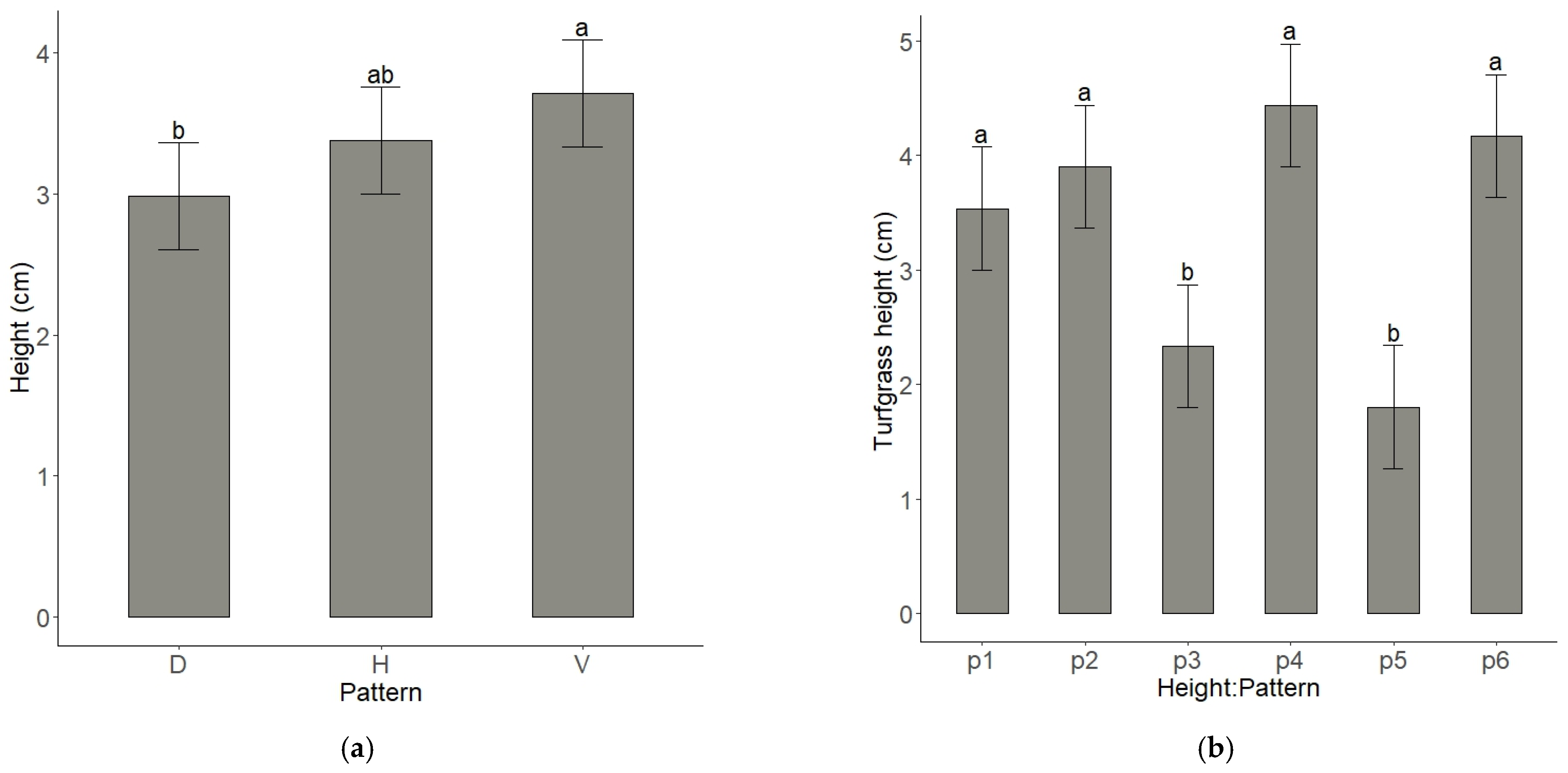
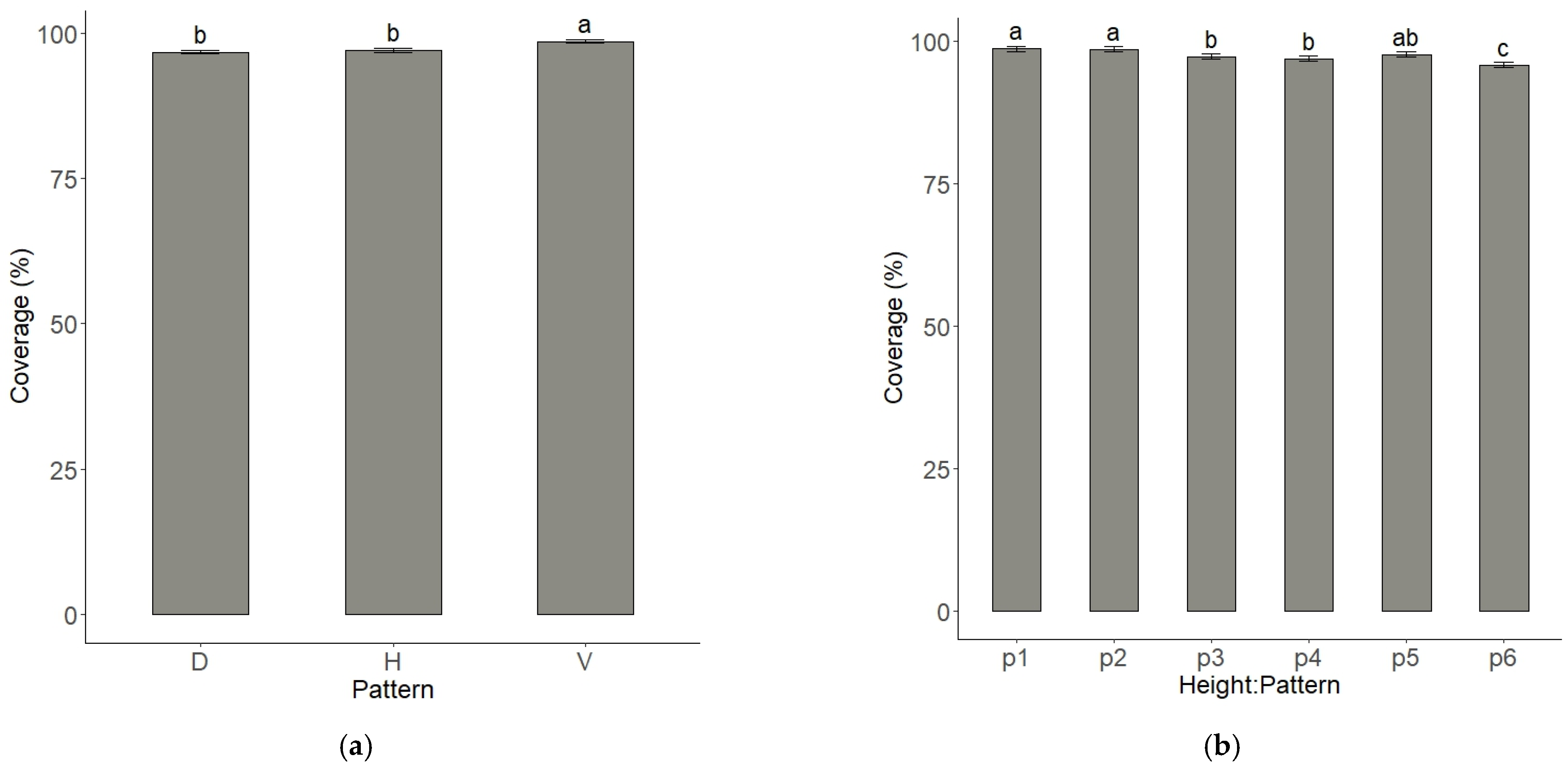
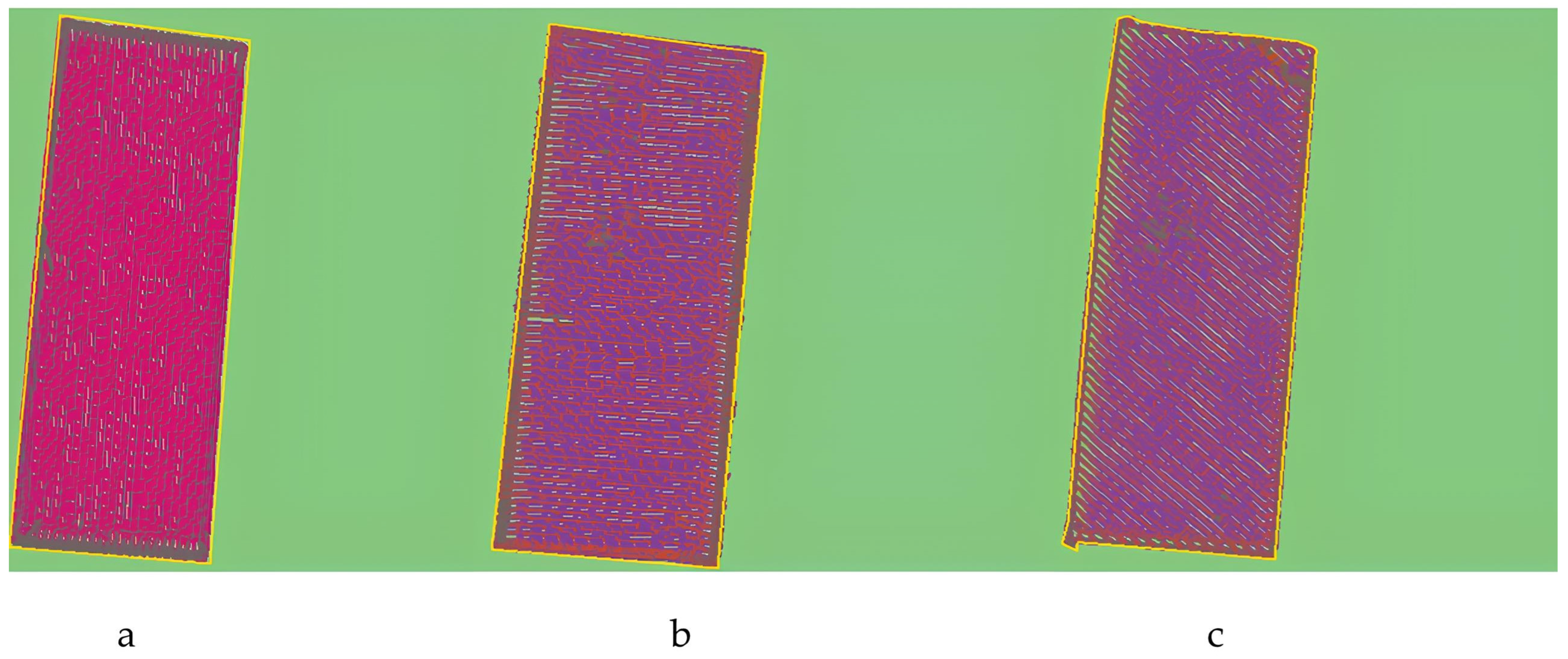
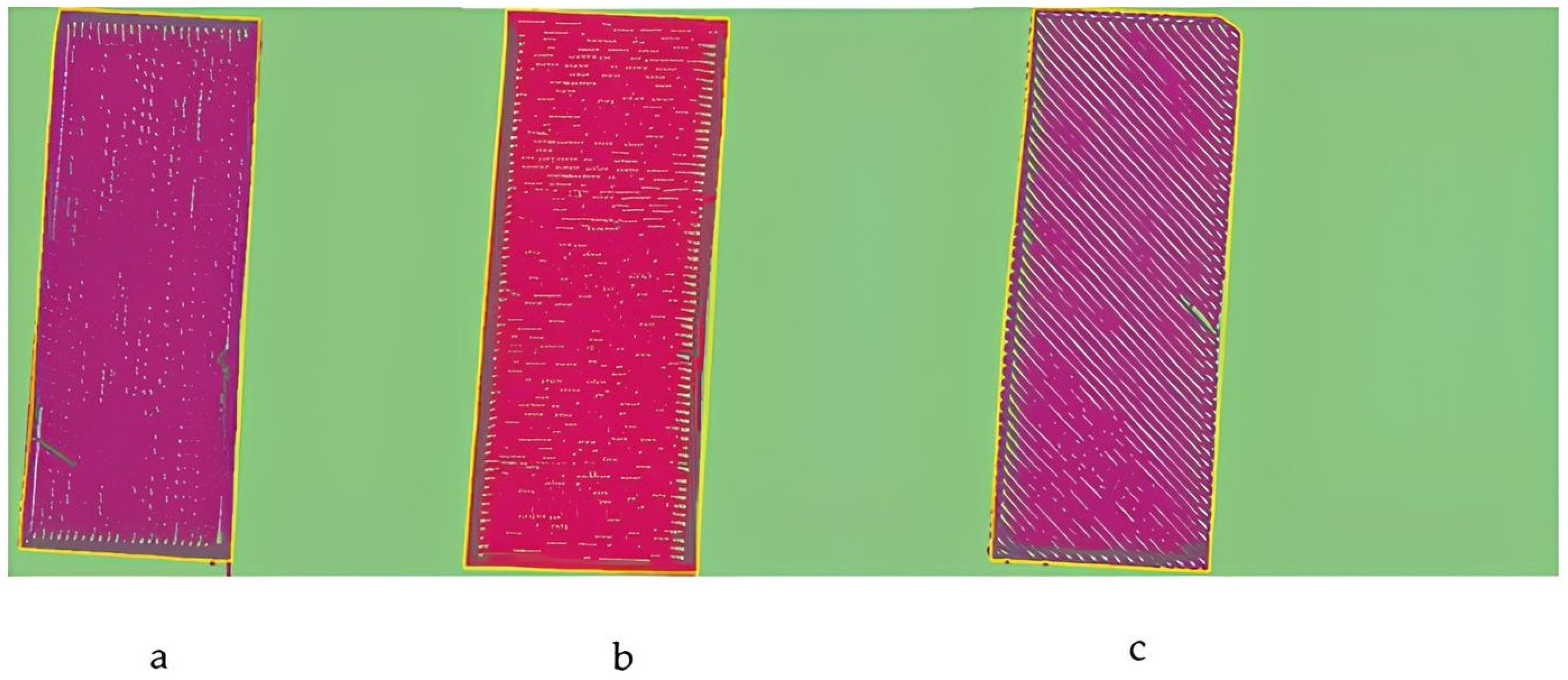



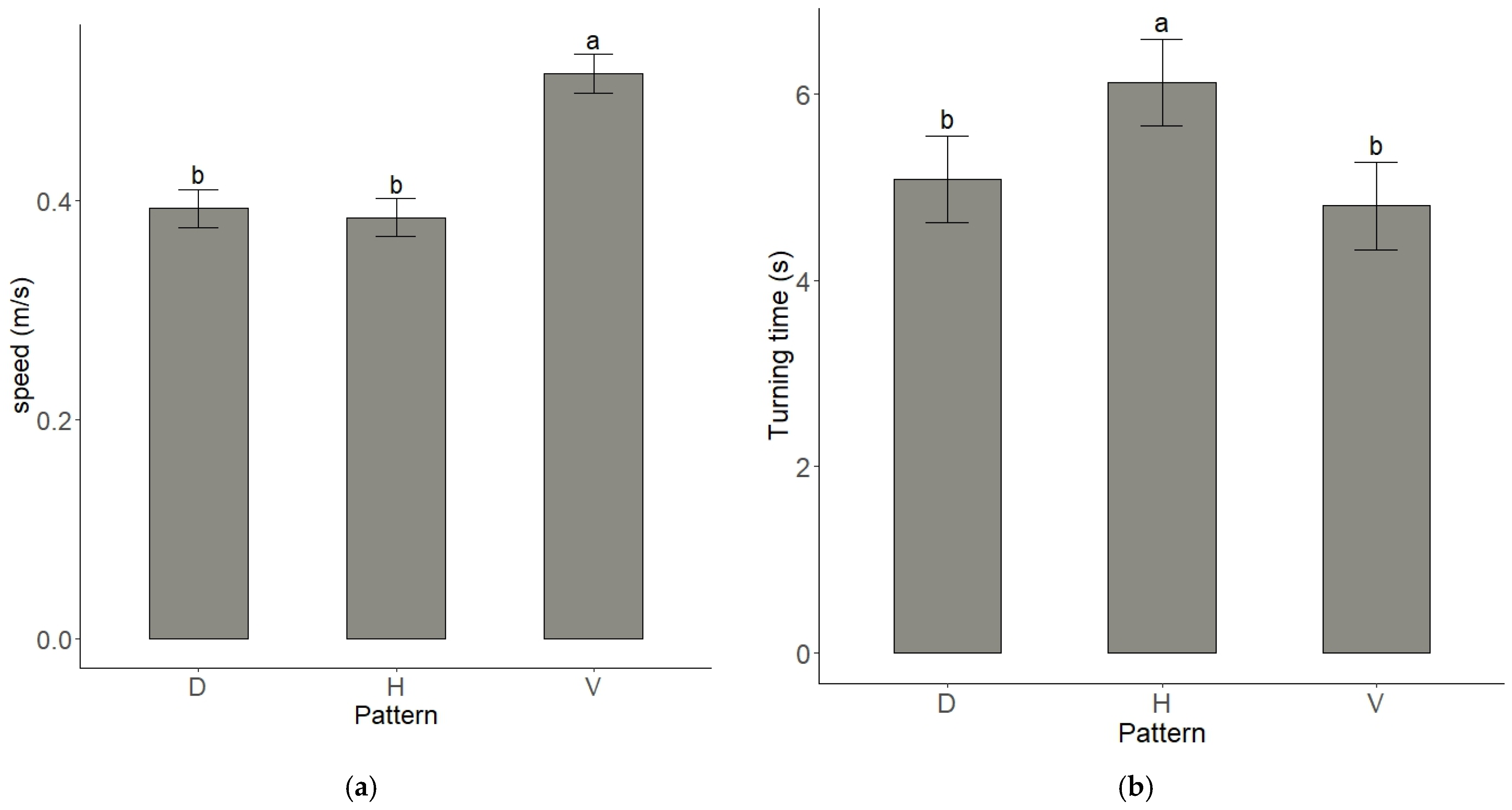
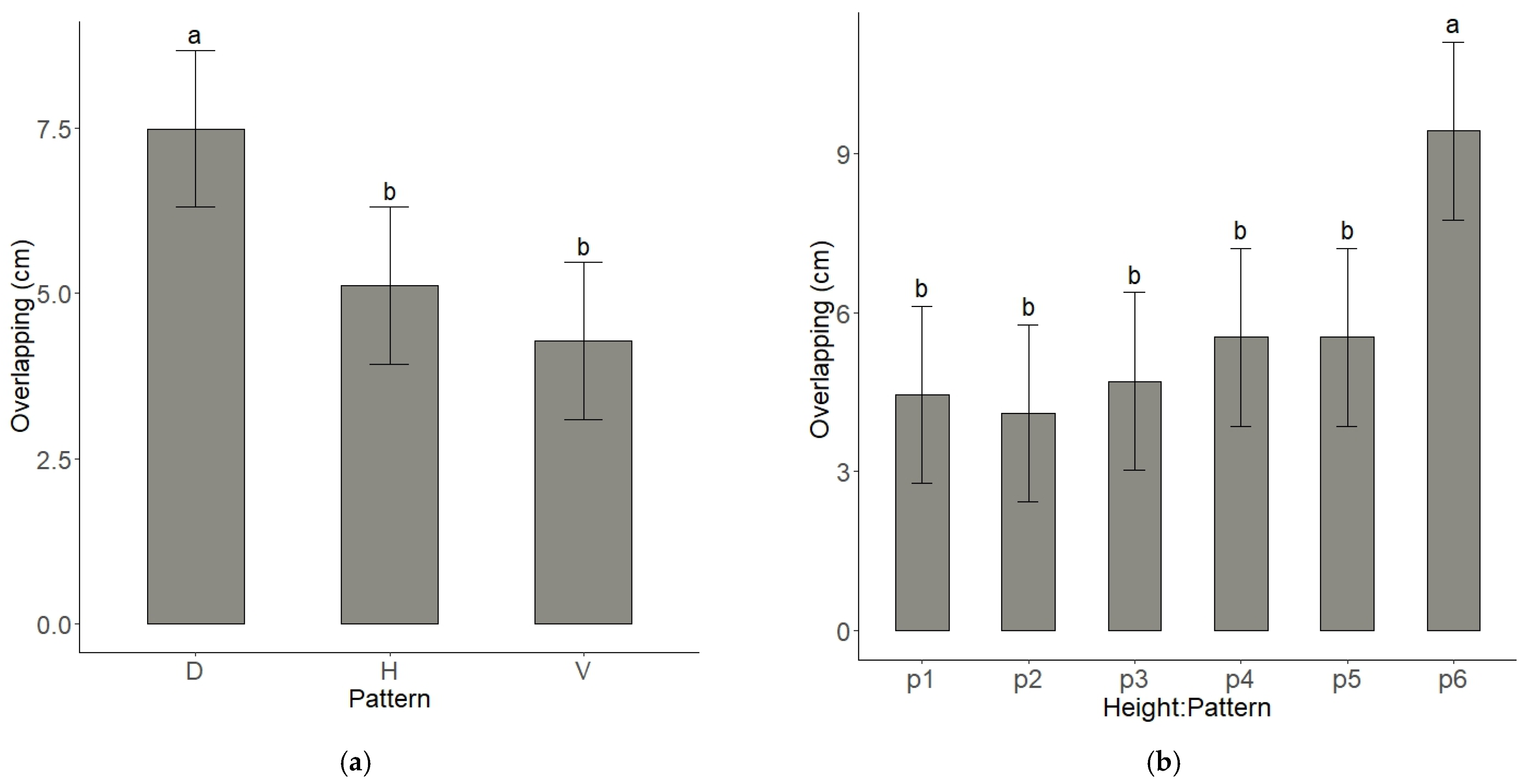
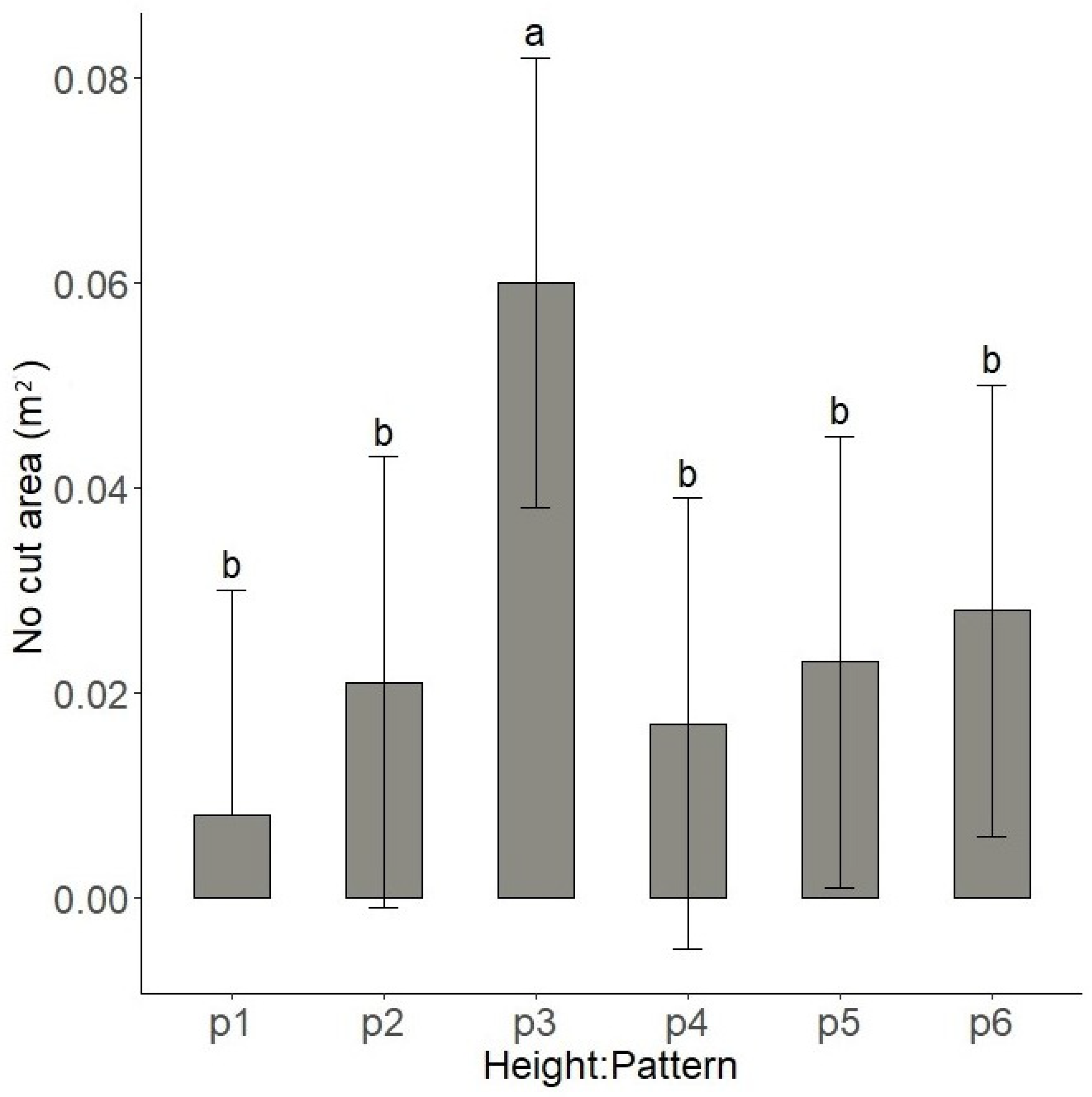
| Source | Parameter | Mean Square | F | p 1 |
|---|---|---|---|---|
| Cutting Height | Height | 11.681 | 67.012 | *** |
| Coverage | 2.681 | 20.818 | ** | |
| Theoretical mowed area | 79.195 | 56.650 | *** | |
| Actual mowed area | 17.370 | 20.818 | ** | |
| Efficiency | 0.000 | 25,994.32 | *** | |
| Distance travelled | 1374.919 | 56.650 | *** | |
| Speed | 0.007 | 19.127 | ** | |
| Turning time | 27.259 | 102.97 | *** | |
| Overlapping | 9.607 | 5.648 | * | |
| No cut area 2 | 0.000 | 1.039 | NS | |
| Pattern | Height | 0.809 | 4.641 | * |
| Coverage | 5.903 | 45.826 | *** | |
| Theoretical mowed area | 896.405 | 641.218 | *** | |
| Actual mowed area | 38.235 | 45.826 | *** | |
| Efficiency | 0.005 | 813,036.2 | *** | |
| Distance travelled | 15,562.593 | 641.218 | *** | |
| Speed | 2.921 | 11.033 | *** | |
| Turning time | 2.921 | 11.033 | ** | |
| Overlapping | 16.603 | 9.761 | ** | |
| No cut area 2 | 0.001 | 2.912 | NS | |
| Pattern: Cutting Height | Height | 1.769 | 10.148 | ** |
| Coverage | 1.376 | 10.682 | ** | |
| Theoretical mowed area | 866.484 | 619.815 | *** | |
| Actual mowed area | 8.913 | 10.682 | ** | |
| Efficiency | 0.003 | 562,888.588 | *** | |
| Distance travelled | 15,043.127 | 619.815 | *** | |
| Speed | 0.001 | 2.976 | NS | |
| Turning time | 0.417 | 1.574 | NS | |
| Overlapping | 7.217 | 4.243 | * | |
| No cut area 2 | 0.001 | 4.671 | * |
Disclaimer/Publisher’s Note: The statements, opinions and data contained in all publications are solely those of the individual author(s) and contributor(s) and not of MDPI and/or the editor(s). MDPI and/or the editor(s) disclaim responsibility for any injury to people or property resulting from any ideas, methods, instructions or products referred to in the content. |
© 2025 by the authors. Licensee MDPI, Basel, Switzerland. This article is an open access article distributed under the terms and conditions of the Creative Commons Attribution (CC BY) license (https://creativecommons.org/licenses/by/4.0/).
Share and Cite
Luglio, S.M.; Frasconi, C.; Gagliardi, L.; Raffaelli, M.; Peruzzi, A.; Pieri, S.; Volterrani, M.; Magni, S.; Fontanelli, M. Tracking Long-Distance Systematic Trajectories of Different Robot Mower Patterns with Enhanced Custom-Built Software. AgriEngineering 2025, 7, 30. https://doi.org/10.3390/agriengineering7020030
Luglio SM, Frasconi C, Gagliardi L, Raffaelli M, Peruzzi A, Pieri S, Volterrani M, Magni S, Fontanelli M. Tracking Long-Distance Systematic Trajectories of Different Robot Mower Patterns with Enhanced Custom-Built Software. AgriEngineering. 2025; 7(2):30. https://doi.org/10.3390/agriengineering7020030
Chicago/Turabian StyleLuglio, Sofia Matilde, Christian Frasconi, Lorenzo Gagliardi, Michele Raffaelli, Andrea Peruzzi, Stefano Pieri, Marco Volterrani, Simone Magni, and Marco Fontanelli. 2025. "Tracking Long-Distance Systematic Trajectories of Different Robot Mower Patterns with Enhanced Custom-Built Software" AgriEngineering 7, no. 2: 30. https://doi.org/10.3390/agriengineering7020030
APA StyleLuglio, S. M., Frasconi, C., Gagliardi, L., Raffaelli, M., Peruzzi, A., Pieri, S., Volterrani, M., Magni, S., & Fontanelli, M. (2025). Tracking Long-Distance Systematic Trajectories of Different Robot Mower Patterns with Enhanced Custom-Built Software. AgriEngineering, 7(2), 30. https://doi.org/10.3390/agriengineering7020030









